
Haccp Introduction What Astronauts Eat Food Pictures, Process from Nasa Food Lab
By doing these article i came to know why Haccp has so much to do with processes, Haccp has been developed for NASA scientist travelling to space .In order to keep their food 100% safe from their sourcing to producing and packing. Nasa did this about 40 odd years back does our food Industry do Justice in Implementing HACCP procedure.There are institutions thinks its just paper work don’t they ??
Space Food Systems Laboratory (SFSL)
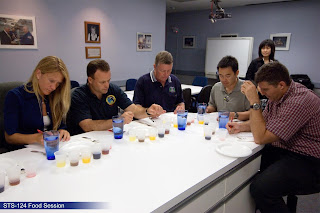 The Space Food Systems Laboratory is a multipurpose laboratory responsible for space food and package research and development. This facility designs, develops, evaluates and produces flight food, menus, packaging, and food-related ancillary hardware for Shuttle, Space Station, and Advanced Food Systems. Capabilities of this facility include: food product development, food preservation
The Space Food Systems Laboratory is a multipurpose laboratory responsible for space food and package research and development. This facility designs, develops, evaluates and produces flight food, menus, packaging, and food-related ancillary hardware for Shuttle, Space Station, and Advanced Food Systems. Capabilities of this facility include: food product development, food preservation 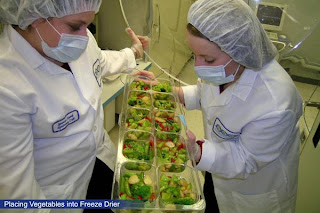 technology, sensory evaluation, menu planning, freeze dehydration, blast freezing, package development, fabrication and design of packaging equipment, physical testing of packages and materials, and modified and controlled atmosphere packaging.
technology, sensory evaluation, menu planning, freeze dehydration, blast freezing, package development, fabrication and design of packaging equipment, physical testing of packages and materials, and modified and controlled atmosphere packaging.
Space Mission / Purpose:
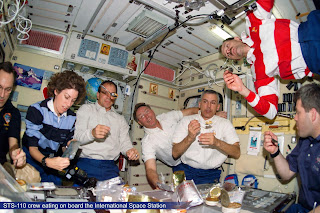
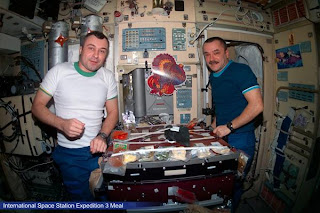 Evidence strongly supports the role of nutrition in maintaining the health and optimal performance of astronauts during space flights and return to Earth. The key to providing good nutrition in support of human space flight is to provide high-quality food products that are appetizing, nutritious, and safe and easy to prepare and eat. The mission of the Space Food Systems Laboratory is to provide high-quality flight food systems that are convenient, compatible with each crew member’s physiological and psychological requirements, meet spacecraft stowage and galley interface requirements, and are easy to prepare and eat in the weightlessness of space.
Evidence strongly supports the role of nutrition in maintaining the health and optimal performance of astronauts during space flights and return to Earth. The key to providing good nutrition in support of human space flight is to provide high-quality food products that are appetizing, nutritious, and safe and easy to prepare and eat. The mission of the Space Food Systems Laboratory is to provide high-quality flight food systems that are convenient, compatible with each crew member’s physiological and psychological requirements, meet spacecraft stowage and galley interface requirements, and are easy to prepare and eat in the weightlessness of space.
Technical Specifications of Facility:
The Space Food Systems Laboratory is located in Building 17 at Johnson Space Center and is comprised of four laboratories: a Test Kitchen, fully equipped with sensory testing capabilities; a Food Processing Laboratory (Pilot Plant); a Food Packaging Laboratory; and an Analytical Laboratory. The Space Food Systems Laboratory has the capability to fabricate custom-molded flight food containers; process foods using a variety of stabilization techniques, including freezing and freeze-drying; package foods in a nitrogen environment for long-term storage; provide long-term controlled environment storage for processed foods; conduct physical and sensory analyses of food; evaluate prototype and flight food preparation hardware; and, develop food preparation and serving techniques for space flight.
Advanced Food Technology Project
The AFT project is responsible for providing space flight crews with a food system that is safe, nutritious, and acceptable to the crew, while efficiently balancing appropriate vehicle mass, volume, waste, and food preparation time for exploration missions. This will require a packaged food system with a shelf life of 3 to 5 years – current shuttle and ISS food system technologies do not meet these requirements. Food not only provides nutrition for astronauts, but also enhances the psychological well-being of the crew by establishing a familiar element in an unfamiliar and hostile environment.
Evaluation of Food Packaging
As part of the package configuration evaluation, a gusseted bag (right) was evaluated to replace the tray and lid design (left). The design has yet to be implemented.
A total system approach is an operating system that considers each parameter of an overall process and seeks to optimize each of these parameters to maximize the total output. Exploration food systems require low mass, high quality, and long shelf life. Packaging failures, excess material, or oxygen trapped within the package can be detrimental to this system. To determine which packaging parameters can be modified to influence food system mass and food shelf life, an evaluation of package sealing conditions, seal width, vacuum flush procedures, and package configurations was conducted.
As a result of the evaluation, changes have been implemented in the ISS provisioning processes. Minimum temperatures were determined for optimum sealing of pouches and rehydratable packages. Improved vacuum flush settings were also identified and implemented as a result of the study.
During the package configuration evaluation, a gusseted pouch was designed to replace the current tray and lid design. The design change itself did not significantly affect the mass, but would enable a change in film material to save about 200 grams per container and decrease packaging time by 66 percent.
Trade Study – Food Processing vs. Packaged Food System
 African Sweet Potato and Peanut Soup, Flourless Peanut Butter Cookies, and Spanish Rice are three of the dishes incorporated into the 10-day menu cycle for food systems utilizing the bioregenerative and bulk ingredient food sources.
African Sweet Potato and Peanut Soup, Flourless Peanut Butter Cookies, and Spanish Rice are three of the dishes incorporated into the 10-day menu cycle for food systems utilizing the bioregenerative and bulk ingredient food sources.
The current crewmember diet is completely supplied through prepackaged, shelf-stable food items produced on Earth. The duration of future missions may require a portion of the diet to be grown, processed, and prepared in the space habitat. To determine the degree to which food processing and a bioregenerative food system should be utilized on Mars habitat missions, a trade study comparing several bioregenerative and prepackaged menu scenarios is underway.
The scenarios for comparison were established during 2010 using multiple food source combinations from farmed or shipped salad crops, bulk crops, and prepackaged dishes. Three 10-day menu cycles with similar calories and nutrient intake were created. The food metric value (FMV) of each scenario will be computed and used for final analysis.
Analysis of the required mass of food associated with each system revealed that the food up-mass of the completely prepackaged food system was more than double the mass of the closest system despite the prepackaged system having a significant fraction of freeze-dried foods. However, equipment mass, volume, and power as well as crew time are also factors in the equivalent system mass calculations and subsequent FMV.
Over the next two years, the remaining factors will be evaluated and an informed recommendation will be provided to mission planners as to the optimum food system for long-duration habitat missions.
Effect of Processing and Subsequent Storage on Nutrition
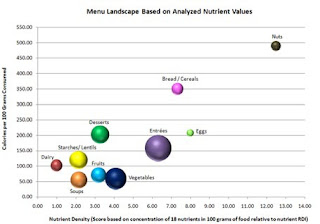 A graphic showing the nutrient and caloric density of food categories analyzed in the nutrition study. Nuts are clearly the most efficient in terms of nutrients and calories per gram.
A graphic showing the nutrient and caloric density of food categories analyzed in the nutrition study. Nuts are clearly the most efficient in terms of nutrients and calories per gram.
Crewmembers rely on the foodstuffs provided through NASA to meet their nutritional requirements. Because vitamin degradation occurs with heat processing, oxidation, and light exposure, it is likely that the commercially sterile foods of the space program have reduced nutrient profiles at the time they are consumed.
To evaluate the nutritional quality of foods currently used for prolonged space missions, a study to examine the vitamin and mineral levels of space food after processing and long storage times of up to five years is ongoing. Food samples are analyzed for nutrient content immediately after stabilization processing and at one year and three years to understand storage impact.
During 2010, twenty new foods were added to the ground study. Twenty-six food items underwent repeat analytical testing on the anniversary of their original stabilization processing. Incongruities in the estimates prevented researchers from drawing broad conclusions about vitamin stability during processing. A detailed look at some of the food products confirmed the following: degradation of some of the more sensitive vitamins; a chemical conversion which increases vitamin D; and manufacturers overfortification of commercial beverage powders. This study will continue until 2012 and will analyze each of the NASA space food items.
